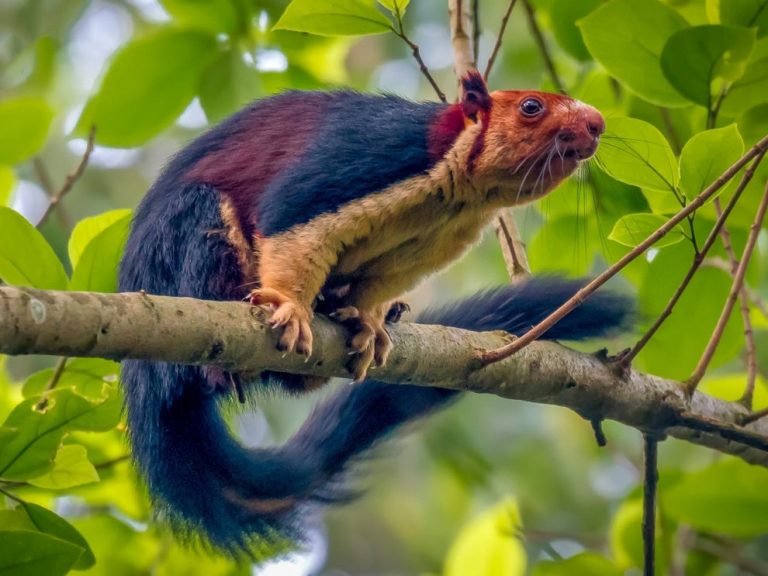Indian giant squirrel

The Malabar Giant Squirrels (or Indian Giant Squirrel) are an endemic Indian species, found throughout India in places like the Western Ghats, Eastern Ghats and the Satpura Range in states such as Madhya Pradesh. Body length-wise, they are 20-25 cm, their tail around 45cm in length, and their weight from 1.5-2kg. They are two times the size of the Eastern Grey Squirrel.
Their colour tone is a one, two, or three-toned colour scheme. Its colours include white, creamy-beige, buff, tan, rust reddish-maroon, brown, dark brown, or black.
The colours act as a camouflage to protect the squirrel from predators. Broadleaf habitats of the squirrels exhibit a “mosaic of sun flecks and dark, shaded areas” which is like the patterns of the Giant Malabar Indian Squirrel.
The Malabar Giant Squirrels can leap up to 20 ft. and they can travel between close trees with limited effort. Their long and strong claws help them climb trees with ease. Their flexibility and cautious attitude help them avoid predators.

Diet, Habitat, Predators, and Behaviour:
Their diet includes consists of jackfruit native to India, other fruit, flowers, nuts, and tree bark. The omnivorous species eat insects, and sometimes, bird eggs.
Malabar Giant Squirrels live in the tropical evergreen forests of India. They are an upper-canopy dwelling species that stay in the treetop and rarely touch the ground. They make their nests on the nooks of the thinner branches or in tree holes.
The nests’ sizes are like that of eagle nests and consist of twigs and leaves. Some individuals and pairs of squirrels live in over one nest. They leap from one tree to another in search of food. These creatures have a quirky method of storing their food. Unlike other squirrels, the Malabar Giant Squirrel creates large caches of food high in the treetops.
Predators include leopards, lion-tailed macaques, crested serpent eagles, other big cats, snakes, and other big birds of prey.
Their tail aids their balance while they roam on precarious branches. Malabar Giant Squirrels have a unique way of avoiding predators. They flatten themselves against a branch and utilise their unique colour pattern to make it look like they are apart of the tree.
There is limited knowledge about the breeding and mating habits of these unique creatures. The only known aspect is that their litter can include one to three squirrels and that breeding occurs at any time of the year. Their lifespan in the wild is unknown. However, in captivity, the longest they have lived in 20 years.
Threats and conservation efforts:
These wonderful creatures are facing many threats to their survival. Deforestation, hunting, fragmentation of their habitats and captivity as pets are just some threats that the Malabar Giant Squirrel faces. There are efforts being made to help conserve their populations, but they are difficult to look after due to certain behavioural traits.
The IUCN (International Union for Conservation of Nature) Red List of threatened species did a worldwide assessment on the species. The assessment confirmed that despite the decline, the squirrel’s numbers remain of “least concern” on the organization’s scale.
Conservation efforts despite all the challenges are being made to help improve the Malabar Giant Squirrel’s population. Implementation of Wildlife Protection Acts and legislations that ban hunting and keeping them as pets, help preserve the Malabar Giant populations.
Wildlife Parks and Zoos including the Rajiv Gandhi National Zoological Park in Pune are helping boost the population of the Malabar Giant Squirrel. These are just some conservation efforts being made to protect the Malabar Giant Squirrel.
Sources:
https://www.conservationindia.org/gallery/captive-malabar-giant-squirrel
https://www.thedodo.com/in-the-wild/indian-giant-squirrel-pictures
https://www.nationalgeographic.com/animals/2019/04/indian-giant-squirrels-colors-camouflage/

